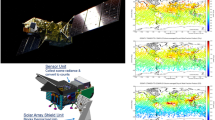Abstract
Facing the major scientific issues of the global carbon cycle and the monitoring demand for carbon emission reduction all over the world, this paper researches and develops a new calculation method for space-based remote sensing detection of greenhouse gas-flux based on the atmospheric boundary layer turbulence transport theory and the active detection of coherent differential absorption lidar system. By obtaining the atmospheric wind profile information, gas concentration profile information and the new calculation method for space-based gas-flux proposed in this paper, the near-surface gas-flux information in the detected area can be directly obtained. So it can innovatively realize the space-based active and direct remote sensing of the atmospheric boundary layer gas-flux. The method in this paper not only can make up the blank in the space-based active detection of greenhouse gas-flux, but also can realize the high spatial and temporal resolution measurement of the three-dimensional atmospheric motion. It reduces assumptions and errors of the existing model based on the column concentration assimilation inversion method, so it can realize a direct and active observation of global multi-scale, high-quality, long-sequence gas-flux.




Similar content being viewed by others
References
Nauels A et al (2019) Attributing long-term sea-level rise to Paris Agreement emission pledges. Proc Natl Acad Sci 116(47):23487–23492
Hansen J, Sato M (2004) Greenhouse gas growth rates. Proc Natl Acad Sci 101(46):16109–16114
Stocker T (ed) (2014) Climate change 2013: the physical science basis: Working Group I contribution to the fifth assessment report of the Intergovernmental Panel on Climate Change. Cambridge University Press
Merlone A, Coppa G, Sanna F et al (2016) Metrology for climate observation. GCOS Sci Conf 2016:1–1
Qin DH et al (2014) Cryosphere change and its impact on climate in China. Acta Meteorol Sin 72(05):869–879
Cunde X, Shijin W, Dahe Q et al (2016) Cryosphere service function and its value evaluation. Clim Change Res 12(01):45–52
Yongjian D, Cunde X (2013) An introduction to the main scientific issues in the study of cryospheric changes and their effects. Adv Earth Sci 28(10):1067–1076
Kaimal JC, Finnigan JJ (1994) Atmospheric boundary layer flows: their structure and measurement. Oxford University Press
Lee X (2018) Fundamentals of boundary-layer meteorology. Springer International Publishing
Emeis S (2010) Surface-based remote sensing of the atmospheric boundary layer. Springer Science and Business Media
Lees KJ, Quaife T, Artz RRE et al (2018) Potential for using remote sensing to estimate carbon fluxes across northern peatlands—a review. Sci Total Environ 615:857–874
Hardesty RM (1984) Coherent DIAL measurement of range resolved water vapor concentration. Appl Opt 23:2545–2553
Michalak A, Miller C, Briwell E et al (2008) ASCENDS—active sensing of CO2 emissions over nights, days, and seasons (ASCENDS) mission. Technical report. University of Michigan in Ann Arbor, Michigan
Ingmann P, Bensi P, Duran Y et al (2008) A-scope—advanced space carbon and climate observation of planet earth. ESA Report for Assessment, SP-1313/1. ESA, 2008
Ehret G, Bousquet P, Pierangelo C et al (2017) MERLIN: a French-German space lidar mission dedicated to atmospheric methane. Remote Sens 9(10):1052
Koch GJ et al (2004) Coherent differential absorption lidar measurements of CO2. Appl Opt 43(26):5092–5099
Abshire JB, Riris H, Allan GR et al (2010) pulsed airborne Lidar measurements of atmospheric CO2 column absorption. Tellus B 62(5):770–783
Ehret G, Kiemle C, Wirth M et al (2008) Space-borne remote sensing of CO2, CH4, and N2O by integrated path differential absorption lidar: a sensitivity analysis. Appl Phys B 90(3):593–608
Marseille, Stoffelen, Barkmeijer (2008) Impact assessment of prospective spaceborne Doppler wind lidar observation scenarios. Tellus A Dyn Meteorol Oceanogr 60(2):234–248
Huffaker RM (1970) Laser Doppler detection systems for gas velocity measurement. Appl Opt 9(5):1026
Hardesty RM, Post MJ, Banta RM (1991) Observing atmospheric winds with a Doppler lidar. Opt Photon News 2(10):12–15
Lotsch HKV (2005) Lidar range-resolved optical remote sensing of the atmosphere
Takashi Fujii TF (2005) Lidar remote sensing
Lettau HH (1979) Wind and temperature profile prediction for diabatic surface layers including strong inversion cases. Bound-Layer Meteorol 17(4):443–464
Lettau H, Davidson B (eds) (1957) Exploring the atmosphere's first mile. In: Proceedings of the Great Plains Turbulence Field Program, 1 August to 8 September 1953, O'Neill, Nebraska. Symposium Publications Division, Pergamon Press, 1957
Viswanadham Y (1979) Relation of Richardson number to the curvature of the wind profile. Bound-Layer Meteorol 17(4):537–544
Donnou HEV et al (2019) Vertical profile of wind diurnal cycle in the surface boundary layer over the Coast of Cotonou, Benin, under a convective atmosphere, Hindawi. Adv Meteorol 2019:7530828
Author information
Authors and Affiliations
Corresponding author
Rights and permissions
About this article
Cite this article
Ma, R., Yao, W., Yu, Z. et al. A Direct Calculation Method for Space-Based Active Detection of Greenhouse Gas-Flux. Adv. Astronaut. Sci. Technol. 4, 133–141 (2021). https://doi.org/10.1007/s42423-021-00093-2
Received:
Revised:
Accepted:
Published:
Issue Date:
DOI: https://doi.org/10.1007/s42423-021-00093-2




